Developing Innovation: Organizational Culture and Strategies
VerifiedAdded on 2023/06/11
|11
|2942
|130
Report
AI Summary
This report delves into the crucial aspects of fostering creativity and innovation within organizations. It emphasizes the significance of organizational culture in motivating employees to generate innovative ideas. The report highlights the roles of leaders, managers, and HR departments in promoting an environment conducive to creativity, considering cognitive diversity and various thinking styles. It further discusses the application of design thinking as a problem-solving approach and the importance of brainstorming as a collaborative tool for idea generation. The report also touches upon the impact of cognitive thinking styles on organizational performance and the need for organizations to adopt contemporary approaches to remain competitive and meet evolving market demands. It concludes by emphasizing the role of communication in brainstorming sessions for effective problem-solving and opportunity creation.
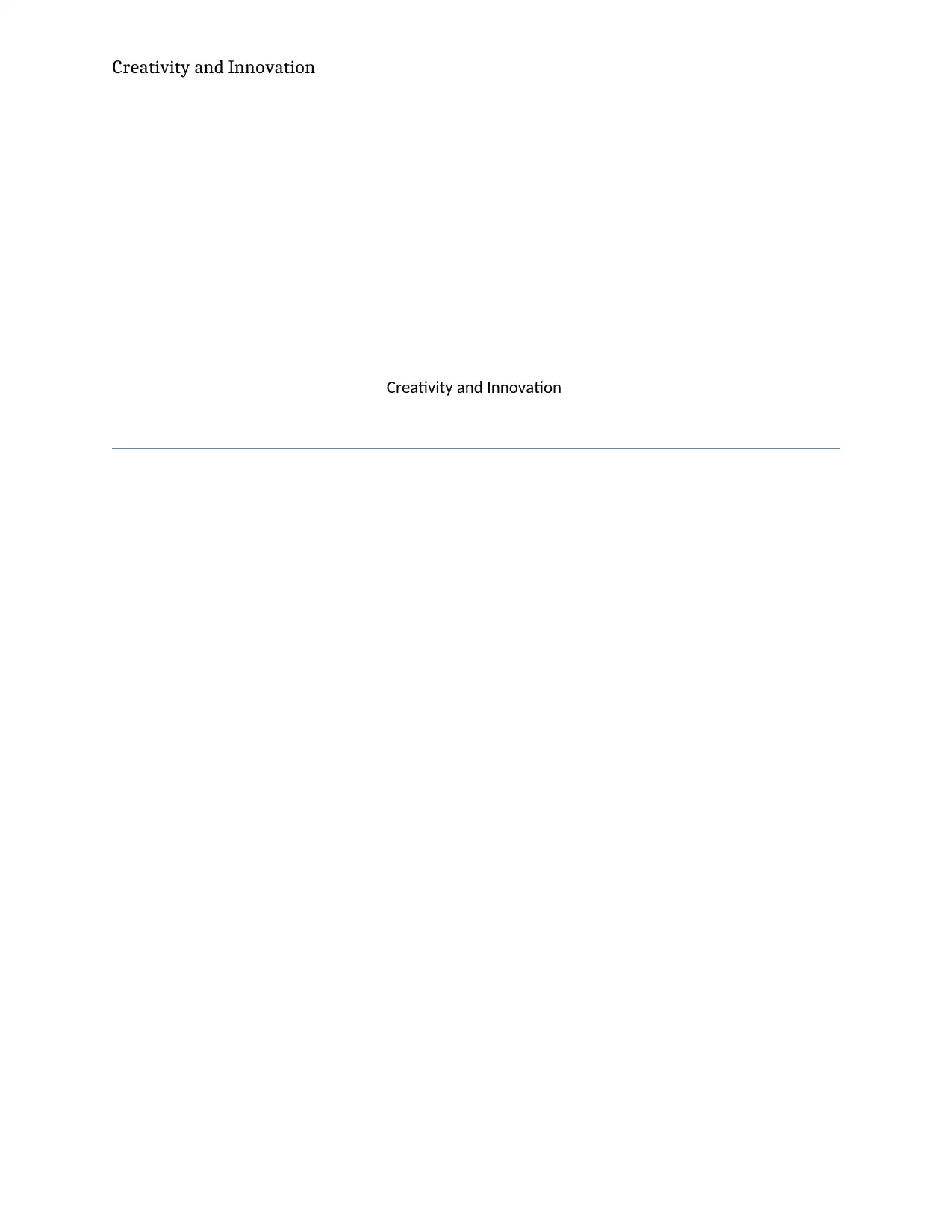
Creativity and Innovation
Creativity and Innovation
Creativity and Innovation
Paraphrase This Document
Need a fresh take? Get an instant paraphrase of this document with our AI Paraphraser
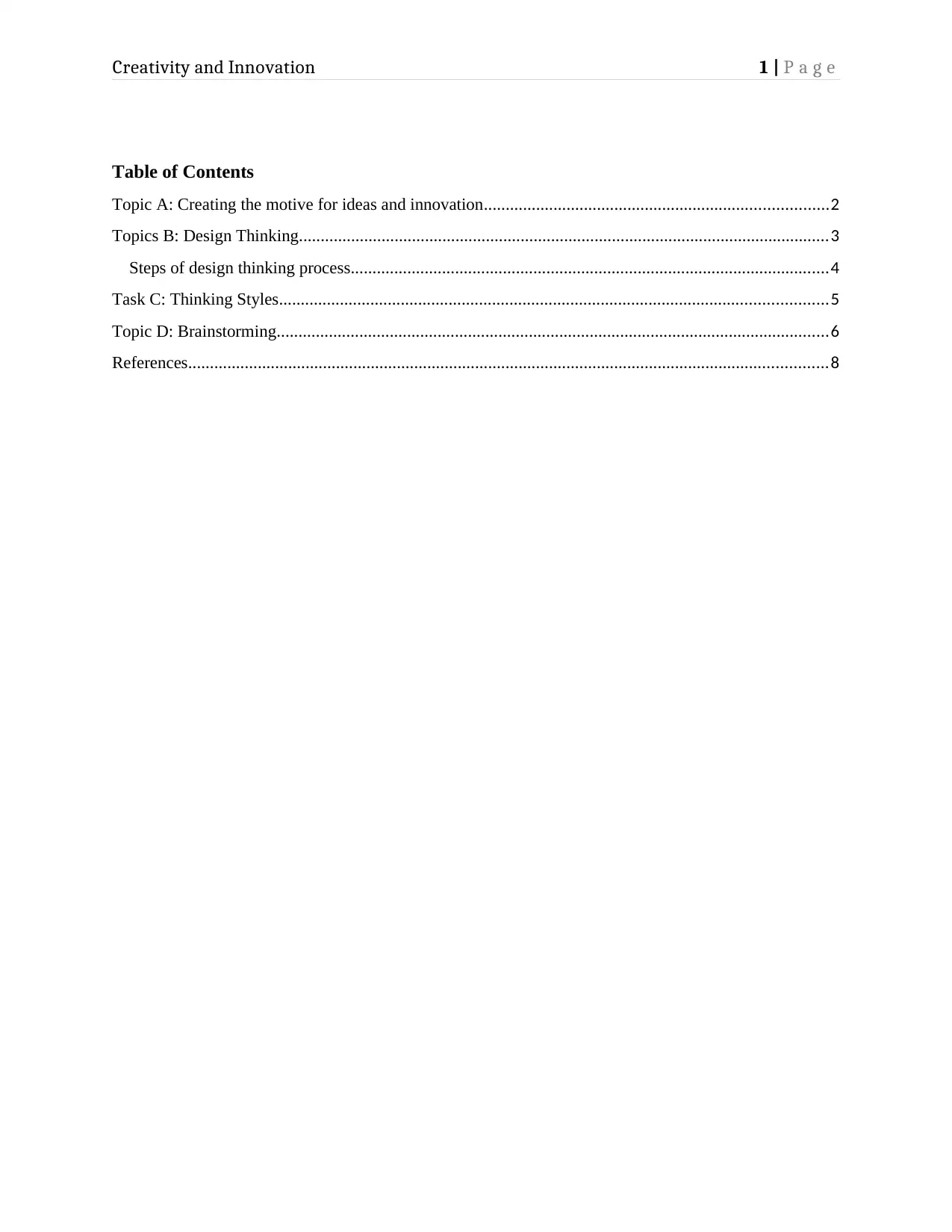
Creativity and Innovation 1 | P a g e
Table of Contents
Topic A: Creating the motive for ideas and innovation...............................................................................2
Topics B: Design Thinking..........................................................................................................................3
Steps of design thinking process..............................................................................................................4
Task C: Thinking Styles..............................................................................................................................5
Topic D: Brainstorming...............................................................................................................................6
References...................................................................................................................................................8
Table of Contents
Topic A: Creating the motive for ideas and innovation...............................................................................2
Topics B: Design Thinking..........................................................................................................................3
Steps of design thinking process..............................................................................................................4
Task C: Thinking Styles..............................................................................................................................5
Topic D: Brainstorming...............................................................................................................................6
References...................................................................................................................................................8
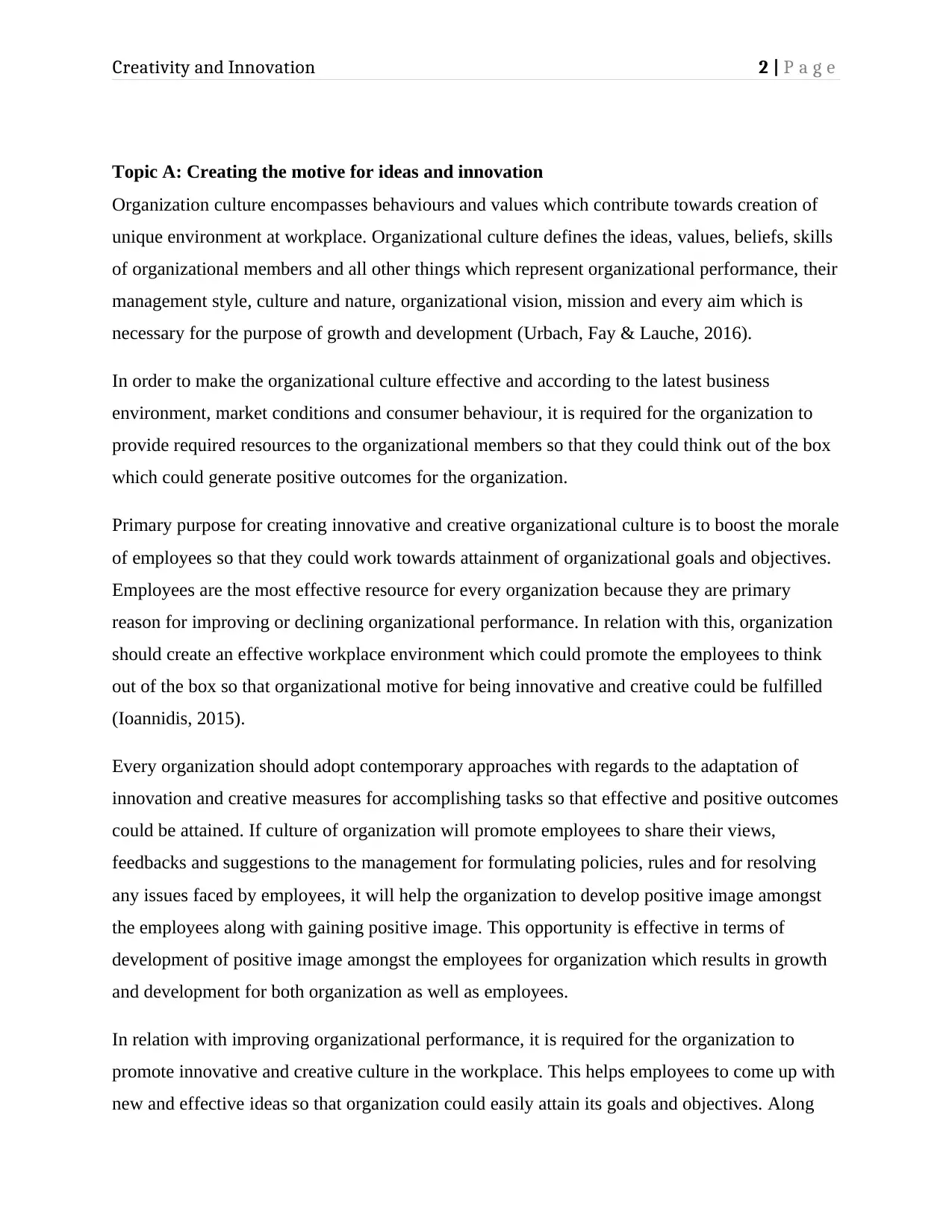
Creativity and Innovation 2 | P a g e
Topic A: Creating the motive for ideas and innovation
Organization culture encompasses behaviours and values which contribute towards creation of
unique environment at workplace. Organizational culture defines the ideas, values, beliefs, skills
of organizational members and all other things which represent organizational performance, their
management style, culture and nature, organizational vision, mission and every aim which is
necessary for the purpose of growth and development (Urbach, Fay & Lauche, 2016).
In order to make the organizational culture effective and according to the latest business
environment, market conditions and consumer behaviour, it is required for the organization to
provide required resources to the organizational members so that they could think out of the box
which could generate positive outcomes for the organization.
Primary purpose for creating innovative and creative organizational culture is to boost the morale
of employees so that they could work towards attainment of organizational goals and objectives.
Employees are the most effective resource for every organization because they are primary
reason for improving or declining organizational performance. In relation with this, organization
should create an effective workplace environment which could promote the employees to think
out of the box so that organizational motive for being innovative and creative could be fulfilled
(Ioannidis, 2015).
Every organization should adopt contemporary approaches with regards to the adaptation of
innovation and creative measures for accomplishing tasks so that effective and positive outcomes
could be attained. If culture of organization will promote employees to share their views,
feedbacks and suggestions to the management for formulating policies, rules and for resolving
any issues faced by employees, it will help the organization to develop positive image amongst
the employees along with gaining positive image. This opportunity is effective in terms of
development of positive image amongst the employees for organization which results in growth
and development for both organization as well as employees.
In relation with improving organizational performance, it is required for the organization to
promote innovative and creative culture in the workplace. This helps employees to come up with
new and effective ideas so that organization could easily attain its goals and objectives. Along
Topic A: Creating the motive for ideas and innovation
Organization culture encompasses behaviours and values which contribute towards creation of
unique environment at workplace. Organizational culture defines the ideas, values, beliefs, skills
of organizational members and all other things which represent organizational performance, their
management style, culture and nature, organizational vision, mission and every aim which is
necessary for the purpose of growth and development (Urbach, Fay & Lauche, 2016).
In order to make the organizational culture effective and according to the latest business
environment, market conditions and consumer behaviour, it is required for the organization to
provide required resources to the organizational members so that they could think out of the box
which could generate positive outcomes for the organization.
Primary purpose for creating innovative and creative organizational culture is to boost the morale
of employees so that they could work towards attainment of organizational goals and objectives.
Employees are the most effective resource for every organization because they are primary
reason for improving or declining organizational performance. In relation with this, organization
should create an effective workplace environment which could promote the employees to think
out of the box so that organizational motive for being innovative and creative could be fulfilled
(Ioannidis, 2015).
Every organization should adopt contemporary approaches with regards to the adaptation of
innovation and creative measures for accomplishing tasks so that effective and positive outcomes
could be attained. If culture of organization will promote employees to share their views,
feedbacks and suggestions to the management for formulating policies, rules and for resolving
any issues faced by employees, it will help the organization to develop positive image amongst
the employees along with gaining positive image. This opportunity is effective in terms of
development of positive image amongst the employees for organization which results in growth
and development for both organization as well as employees.
In relation with improving organizational performance, it is required for the organization to
promote innovative and creative culture in the workplace. This helps employees to come up with
new and effective ideas so that organization could easily attain its goals and objectives. Along
⊘ This is a preview!⊘
Do you want full access?
Subscribe today to unlock all pages.

Trusted by 1+ million students worldwide
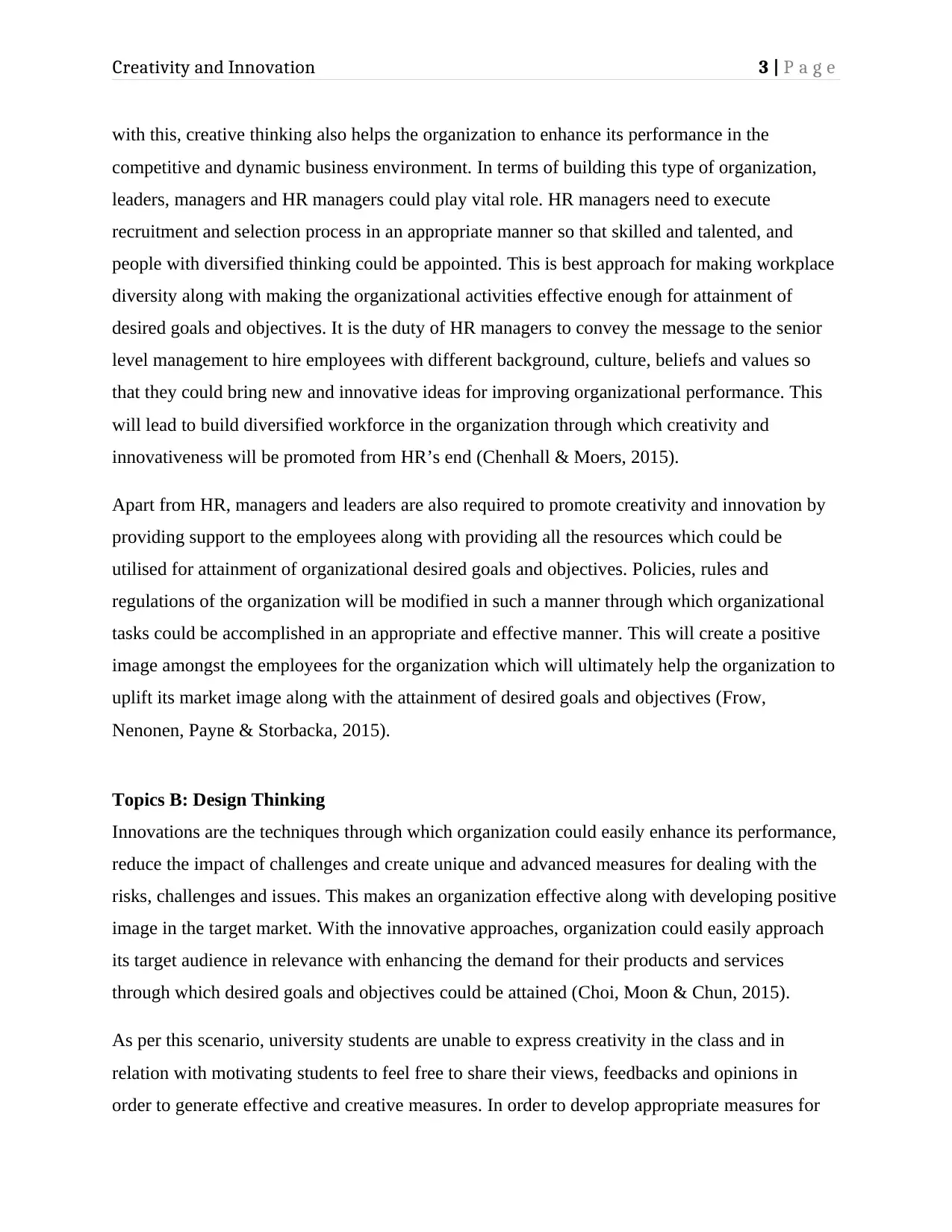
Creativity and Innovation 3 | P a g e
with this, creative thinking also helps the organization to enhance its performance in the
competitive and dynamic business environment. In terms of building this type of organization,
leaders, managers and HR managers could play vital role. HR managers need to execute
recruitment and selection process in an appropriate manner so that skilled and talented, and
people with diversified thinking could be appointed. This is best approach for making workplace
diversity along with making the organizational activities effective enough for attainment of
desired goals and objectives. It is the duty of HR managers to convey the message to the senior
level management to hire employees with different background, culture, beliefs and values so
that they could bring new and innovative ideas for improving organizational performance. This
will lead to build diversified workforce in the organization through which creativity and
innovativeness will be promoted from HR’s end (Chenhall & Moers, 2015).
Apart from HR, managers and leaders are also required to promote creativity and innovation by
providing support to the employees along with providing all the resources which could be
utilised for attainment of organizational desired goals and objectives. Policies, rules and
regulations of the organization will be modified in such a manner through which organizational
tasks could be accomplished in an appropriate and effective manner. This will create a positive
image amongst the employees for the organization which will ultimately help the organization to
uplift its market image along with the attainment of desired goals and objectives (Frow,
Nenonen, Payne & Storbacka, 2015).
Topics B: Design Thinking
Innovations are the techniques through which organization could easily enhance its performance,
reduce the impact of challenges and create unique and advanced measures for dealing with the
risks, challenges and issues. This makes an organization effective along with developing positive
image in the target market. With the innovative approaches, organization could easily approach
its target audience in relevance with enhancing the demand for their products and services
through which desired goals and objectives could be attained (Choi, Moon & Chun, 2015).
As per this scenario, university students are unable to express creativity in the class and in
relation with motivating students to feel free to share their views, feedbacks and opinions in
order to generate effective and creative measures. In order to develop appropriate measures for
with this, creative thinking also helps the organization to enhance its performance in the
competitive and dynamic business environment. In terms of building this type of organization,
leaders, managers and HR managers could play vital role. HR managers need to execute
recruitment and selection process in an appropriate manner so that skilled and talented, and
people with diversified thinking could be appointed. This is best approach for making workplace
diversity along with making the organizational activities effective enough for attainment of
desired goals and objectives. It is the duty of HR managers to convey the message to the senior
level management to hire employees with different background, culture, beliefs and values so
that they could bring new and innovative ideas for improving organizational performance. This
will lead to build diversified workforce in the organization through which creativity and
innovativeness will be promoted from HR’s end (Chenhall & Moers, 2015).
Apart from HR, managers and leaders are also required to promote creativity and innovation by
providing support to the employees along with providing all the resources which could be
utilised for attainment of organizational desired goals and objectives. Policies, rules and
regulations of the organization will be modified in such a manner through which organizational
tasks could be accomplished in an appropriate and effective manner. This will create a positive
image amongst the employees for the organization which will ultimately help the organization to
uplift its market image along with the attainment of desired goals and objectives (Frow,
Nenonen, Payne & Storbacka, 2015).
Topics B: Design Thinking
Innovations are the techniques through which organization could easily enhance its performance,
reduce the impact of challenges and create unique and advanced measures for dealing with the
risks, challenges and issues. This makes an organization effective along with developing positive
image in the target market. With the innovative approaches, organization could easily approach
its target audience in relevance with enhancing the demand for their products and services
through which desired goals and objectives could be attained (Choi, Moon & Chun, 2015).
As per this scenario, university students are unable to express creativity in the class and in
relation with motivating students to feel free to share their views, feedbacks and opinions in
order to generate effective and creative measures. In order to develop appropriate measures for
Paraphrase This Document
Need a fresh take? Get an instant paraphrase of this document with our AI Paraphraser
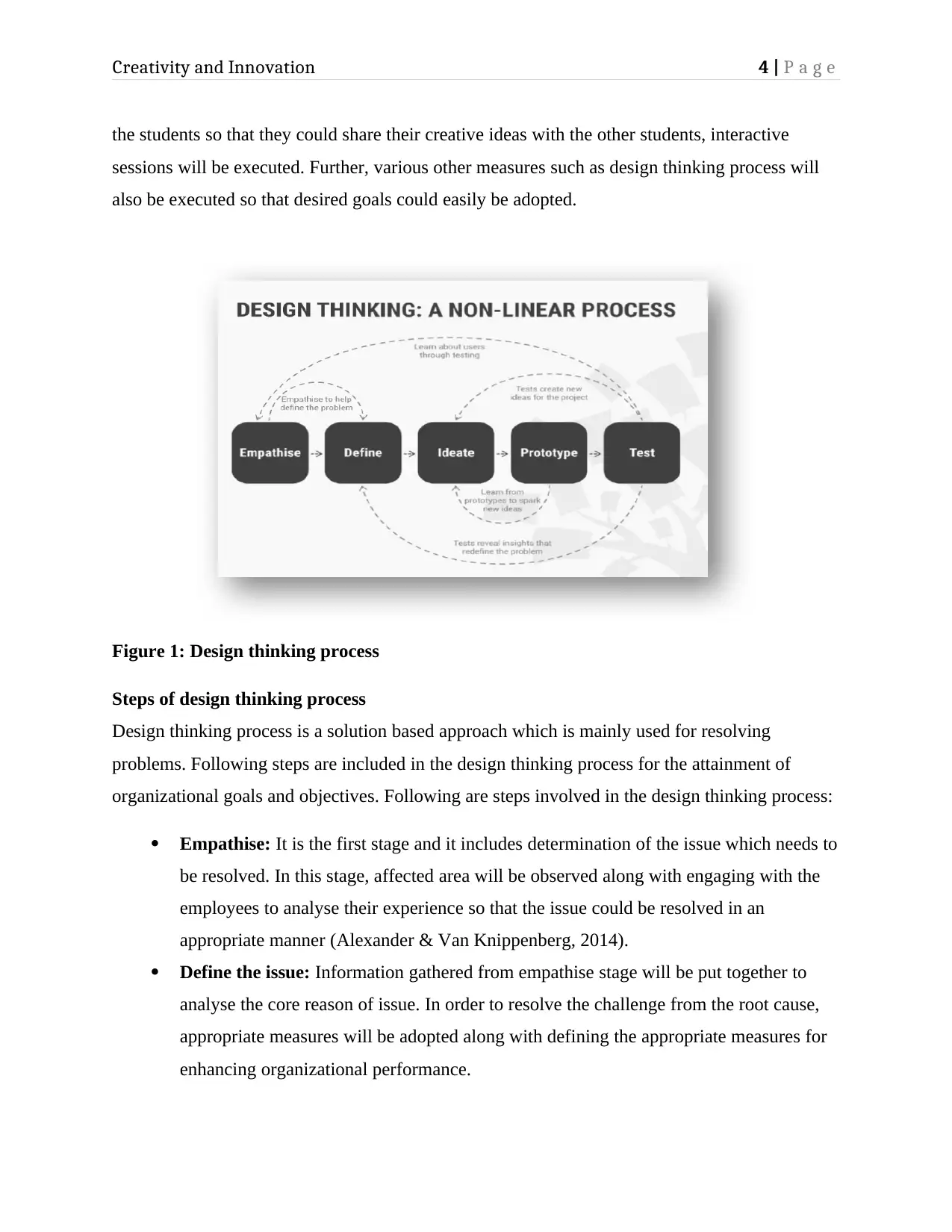
Creativity and Innovation 4 | P a g e
the students so that they could share their creative ideas with the other students, interactive
sessions will be executed. Further, various other measures such as design thinking process will
also be executed so that desired goals could easily be adopted.
Figure 1: Design thinking process
Steps of design thinking process
Design thinking process is a solution based approach which is mainly used for resolving
problems. Following steps are included in the design thinking process for the attainment of
organizational goals and objectives. Following are steps involved in the design thinking process:
Empathise: It is the first stage and it includes determination of the issue which needs to
be resolved. In this stage, affected area will be observed along with engaging with the
employees to analyse their experience so that the issue could be resolved in an
appropriate manner (Alexander & Van Knippenberg, 2014).
Define the issue: Information gathered from empathise stage will be put together to
analyse the core reason of issue. In order to resolve the challenge from the root cause,
appropriate measures will be adopted along with defining the appropriate measures for
enhancing organizational performance.
the students so that they could share their creative ideas with the other students, interactive
sessions will be executed. Further, various other measures such as design thinking process will
also be executed so that desired goals could easily be adopted.
Figure 1: Design thinking process
Steps of design thinking process
Design thinking process is a solution based approach which is mainly used for resolving
problems. Following steps are included in the design thinking process for the attainment of
organizational goals and objectives. Following are steps involved in the design thinking process:
Empathise: It is the first stage and it includes determination of the issue which needs to
be resolved. In this stage, affected area will be observed along with engaging with the
employees to analyse their experience so that the issue could be resolved in an
appropriate manner (Alexander & Van Knippenberg, 2014).
Define the issue: Information gathered from empathise stage will be put together to
analyse the core reason of issue. In order to resolve the challenge from the root cause,
appropriate measures will be adopted along with defining the appropriate measures for
enhancing organizational performance.
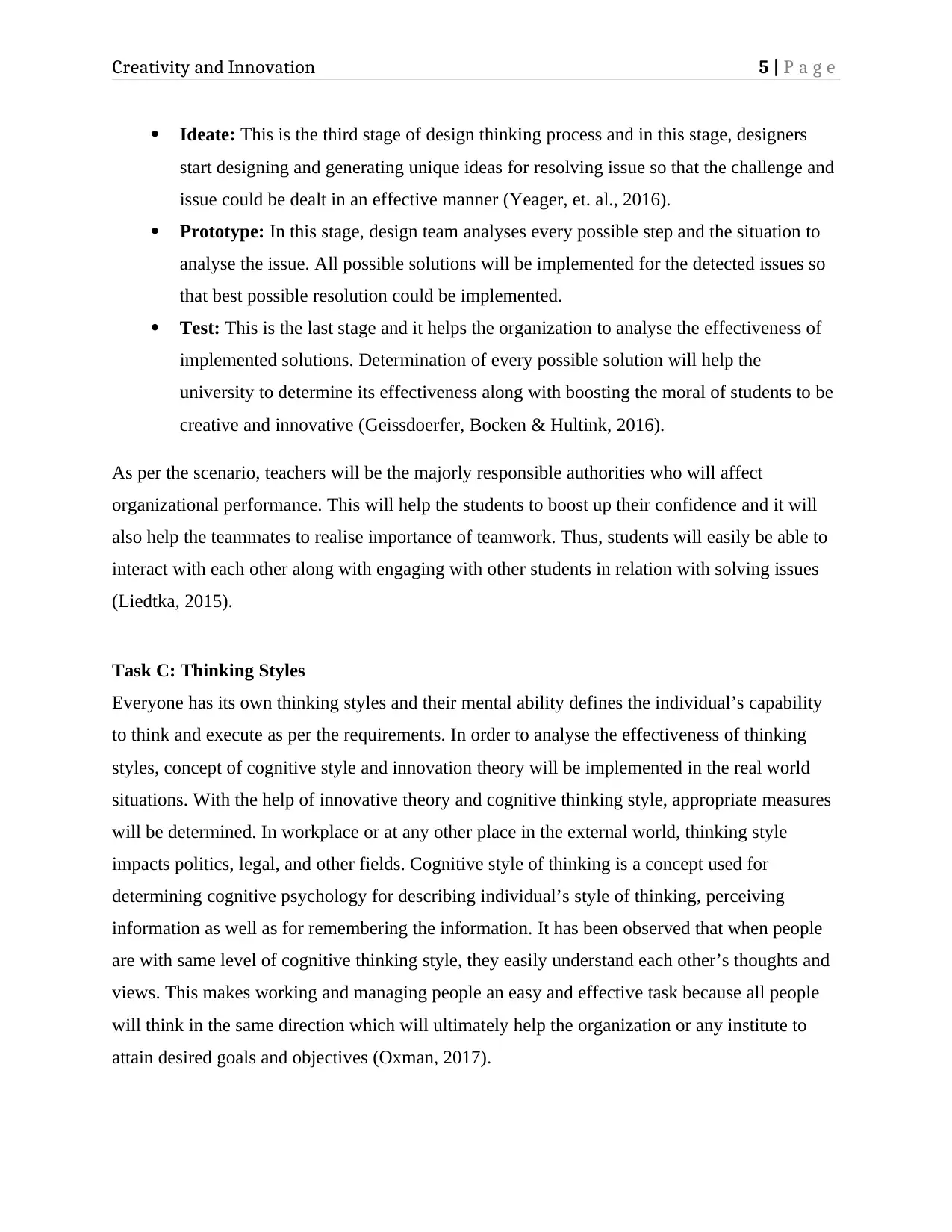
Creativity and Innovation 5 | P a g e
Ideate: This is the third stage of design thinking process and in this stage, designers
start designing and generating unique ideas for resolving issue so that the challenge and
issue could be dealt in an effective manner (Yeager, et. al., 2016).
Prototype: In this stage, design team analyses every possible step and the situation to
analyse the issue. All possible solutions will be implemented for the detected issues so
that best possible resolution could be implemented.
Test: This is the last stage and it helps the organization to analyse the effectiveness of
implemented solutions. Determination of every possible solution will help the
university to determine its effectiveness along with boosting the moral of students to be
creative and innovative (Geissdoerfer, Bocken & Hultink, 2016).
As per the scenario, teachers will be the majorly responsible authorities who will affect
organizational performance. This will help the students to boost up their confidence and it will
also help the teammates to realise importance of teamwork. Thus, students will easily be able to
interact with each other along with engaging with other students in relation with solving issues
(Liedtka, 2015).
Task C: Thinking Styles
Everyone has its own thinking styles and their mental ability defines the individual’s capability
to think and execute as per the requirements. In order to analyse the effectiveness of thinking
styles, concept of cognitive style and innovation theory will be implemented in the real world
situations. With the help of innovative theory and cognitive thinking style, appropriate measures
will be determined. In workplace or at any other place in the external world, thinking style
impacts politics, legal, and other fields. Cognitive style of thinking is a concept used for
determining cognitive psychology for describing individual’s style of thinking, perceiving
information as well as for remembering the information. It has been observed that when people
are with same level of cognitive thinking style, they easily understand each other’s thoughts and
views. This makes working and managing people an easy and effective task because all people
will think in the same direction which will ultimately help the organization or any institute to
attain desired goals and objectives (Oxman, 2017).
Ideate: This is the third stage of design thinking process and in this stage, designers
start designing and generating unique ideas for resolving issue so that the challenge and
issue could be dealt in an effective manner (Yeager, et. al., 2016).
Prototype: In this stage, design team analyses every possible step and the situation to
analyse the issue. All possible solutions will be implemented for the detected issues so
that best possible resolution could be implemented.
Test: This is the last stage and it helps the organization to analyse the effectiveness of
implemented solutions. Determination of every possible solution will help the
university to determine its effectiveness along with boosting the moral of students to be
creative and innovative (Geissdoerfer, Bocken & Hultink, 2016).
As per the scenario, teachers will be the majorly responsible authorities who will affect
organizational performance. This will help the students to boost up their confidence and it will
also help the teammates to realise importance of teamwork. Thus, students will easily be able to
interact with each other along with engaging with other students in relation with solving issues
(Liedtka, 2015).
Task C: Thinking Styles
Everyone has its own thinking styles and their mental ability defines the individual’s capability
to think and execute as per the requirements. In order to analyse the effectiveness of thinking
styles, concept of cognitive style and innovation theory will be implemented in the real world
situations. With the help of innovative theory and cognitive thinking style, appropriate measures
will be determined. In workplace or at any other place in the external world, thinking style
impacts politics, legal, and other fields. Cognitive style of thinking is a concept used for
determining cognitive psychology for describing individual’s style of thinking, perceiving
information as well as for remembering the information. It has been observed that when people
are with same level of cognitive thinking style, they easily understand each other’s thoughts and
views. This makes working and managing people an easy and effective task because all people
will think in the same direction which will ultimately help the organization or any institute to
attain desired goals and objectives (Oxman, 2017).
⊘ This is a preview!⊘
Do you want full access?
Subscribe today to unlock all pages.

Trusted by 1+ million students worldwide
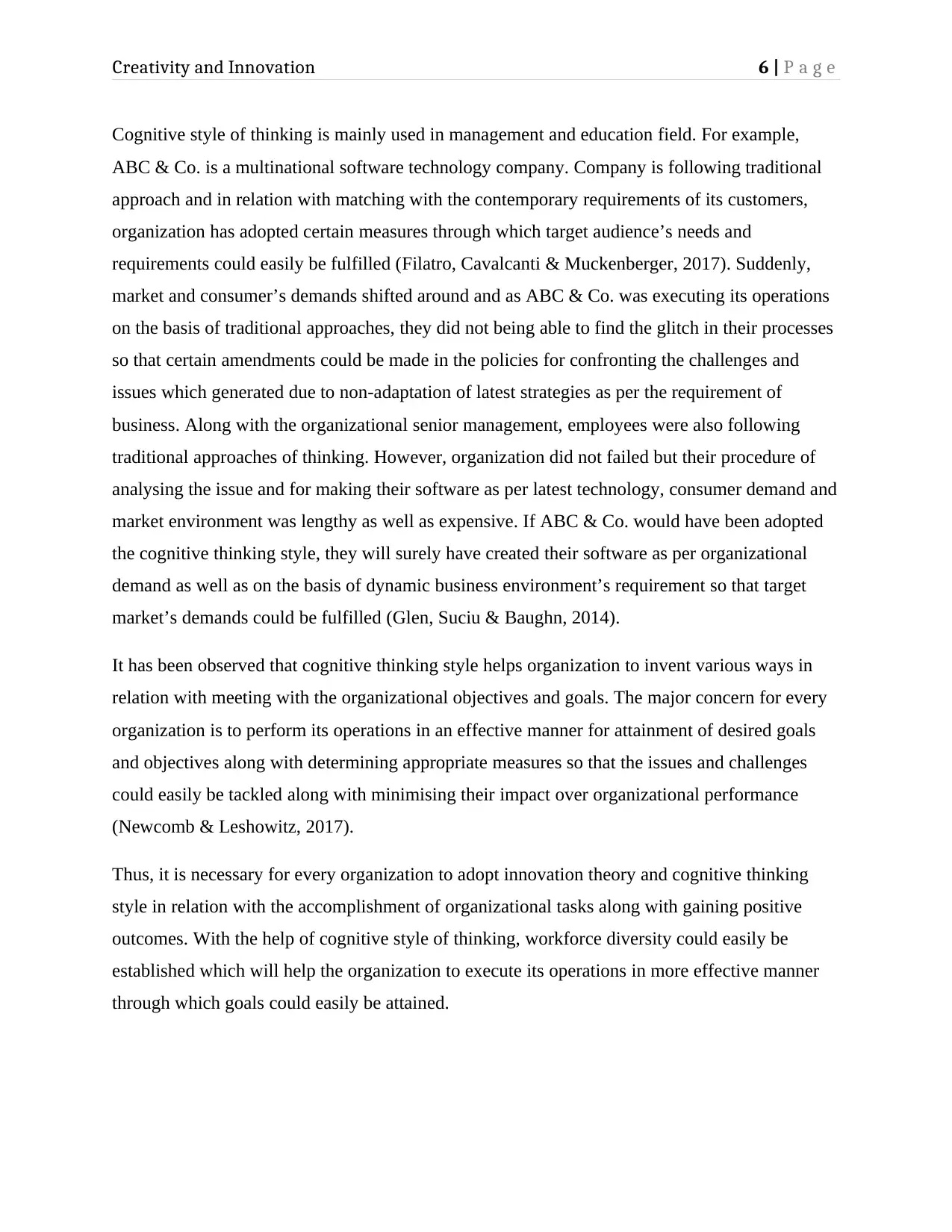
Creativity and Innovation 6 | P a g e
Cognitive style of thinking is mainly used in management and education field. For example,
ABC & Co. is a multinational software technology company. Company is following traditional
approach and in relation with matching with the contemporary requirements of its customers,
organization has adopted certain measures through which target audience’s needs and
requirements could easily be fulfilled (Filatro, Cavalcanti & Muckenberger, 2017). Suddenly,
market and consumer’s demands shifted around and as ABC & Co. was executing its operations
on the basis of traditional approaches, they did not being able to find the glitch in their processes
so that certain amendments could be made in the policies for confronting the challenges and
issues which generated due to non-adaptation of latest strategies as per the requirement of
business. Along with the organizational senior management, employees were also following
traditional approaches of thinking. However, organization did not failed but their procedure of
analysing the issue and for making their software as per latest technology, consumer demand and
market environment was lengthy as well as expensive. If ABC & Co. would have been adopted
the cognitive thinking style, they will surely have created their software as per organizational
demand as well as on the basis of dynamic business environment’s requirement so that target
market’s demands could be fulfilled (Glen, Suciu & Baughn, 2014).
It has been observed that cognitive thinking style helps organization to invent various ways in
relation with meeting with the organizational objectives and goals. The major concern for every
organization is to perform its operations in an effective manner for attainment of desired goals
and objectives along with determining appropriate measures so that the issues and challenges
could easily be tackled along with minimising their impact over organizational performance
(Newcomb & Leshowitz, 2017).
Thus, it is necessary for every organization to adopt innovation theory and cognitive thinking
style in relation with the accomplishment of organizational tasks along with gaining positive
outcomes. With the help of cognitive style of thinking, workforce diversity could easily be
established which will help the organization to execute its operations in more effective manner
through which goals could easily be attained.
Cognitive style of thinking is mainly used in management and education field. For example,
ABC & Co. is a multinational software technology company. Company is following traditional
approach and in relation with matching with the contemporary requirements of its customers,
organization has adopted certain measures through which target audience’s needs and
requirements could easily be fulfilled (Filatro, Cavalcanti & Muckenberger, 2017). Suddenly,
market and consumer’s demands shifted around and as ABC & Co. was executing its operations
on the basis of traditional approaches, they did not being able to find the glitch in their processes
so that certain amendments could be made in the policies for confronting the challenges and
issues which generated due to non-adaptation of latest strategies as per the requirement of
business. Along with the organizational senior management, employees were also following
traditional approaches of thinking. However, organization did not failed but their procedure of
analysing the issue and for making their software as per latest technology, consumer demand and
market environment was lengthy as well as expensive. If ABC & Co. would have been adopted
the cognitive thinking style, they will surely have created their software as per organizational
demand as well as on the basis of dynamic business environment’s requirement so that target
market’s demands could be fulfilled (Glen, Suciu & Baughn, 2014).
It has been observed that cognitive thinking style helps organization to invent various ways in
relation with meeting with the organizational objectives and goals. The major concern for every
organization is to perform its operations in an effective manner for attainment of desired goals
and objectives along with determining appropriate measures so that the issues and challenges
could easily be tackled along with minimising their impact over organizational performance
(Newcomb & Leshowitz, 2017).
Thus, it is necessary for every organization to adopt innovation theory and cognitive thinking
style in relation with the accomplishment of organizational tasks along with gaining positive
outcomes. With the help of cognitive style of thinking, workforce diversity could easily be
established which will help the organization to execute its operations in more effective manner
through which goals could easily be attained.
Paraphrase This Document
Need a fresh take? Get an instant paraphrase of this document with our AI Paraphraser
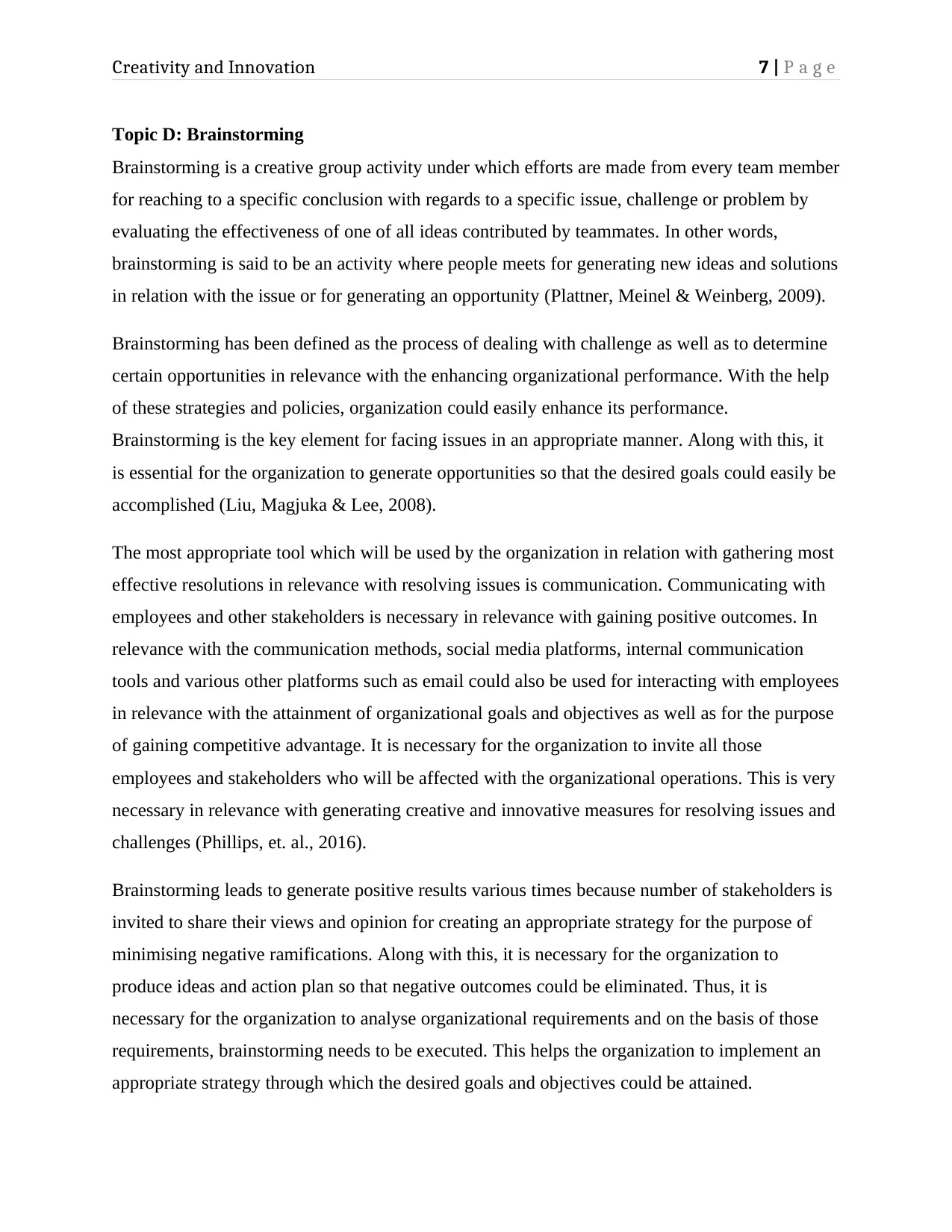
Creativity and Innovation 7 | P a g e
Topic D: Brainstorming
Brainstorming is a creative group activity under which efforts are made from every team member
for reaching to a specific conclusion with regards to a specific issue, challenge or problem by
evaluating the effectiveness of one of all ideas contributed by teammates. In other words,
brainstorming is said to be an activity where people meets for generating new ideas and solutions
in relation with the issue or for generating an opportunity (Plattner, Meinel & Weinberg, 2009).
Brainstorming has been defined as the process of dealing with challenge as well as to determine
certain opportunities in relevance with the enhancing organizational performance. With the help
of these strategies and policies, organization could easily enhance its performance.
Brainstorming is the key element for facing issues in an appropriate manner. Along with this, it
is essential for the organization to generate opportunities so that the desired goals could easily be
accomplished (Liu, Magjuka & Lee, 2008).
The most appropriate tool which will be used by the organization in relation with gathering most
effective resolutions in relevance with resolving issues is communication. Communicating with
employees and other stakeholders is necessary in relevance with gaining positive outcomes. In
relevance with the communication methods, social media platforms, internal communication
tools and various other platforms such as email could also be used for interacting with employees
in relevance with the attainment of organizational goals and objectives as well as for the purpose
of gaining competitive advantage. It is necessary for the organization to invite all those
employees and stakeholders who will be affected with the organizational operations. This is very
necessary in relevance with generating creative and innovative measures for resolving issues and
challenges (Phillips, et. al., 2016).
Brainstorming leads to generate positive results various times because number of stakeholders is
invited to share their views and opinion for creating an appropriate strategy for the purpose of
minimising negative ramifications. Along with this, it is necessary for the organization to
produce ideas and action plan so that negative outcomes could be eliminated. Thus, it is
necessary for the organization to analyse organizational requirements and on the basis of those
requirements, brainstorming needs to be executed. This helps the organization to implement an
appropriate strategy through which the desired goals and objectives could be attained.
Topic D: Brainstorming
Brainstorming is a creative group activity under which efforts are made from every team member
for reaching to a specific conclusion with regards to a specific issue, challenge or problem by
evaluating the effectiveness of one of all ideas contributed by teammates. In other words,
brainstorming is said to be an activity where people meets for generating new ideas and solutions
in relation with the issue or for generating an opportunity (Plattner, Meinel & Weinberg, 2009).
Brainstorming has been defined as the process of dealing with challenge as well as to determine
certain opportunities in relevance with the enhancing organizational performance. With the help
of these strategies and policies, organization could easily enhance its performance.
Brainstorming is the key element for facing issues in an appropriate manner. Along with this, it
is essential for the organization to generate opportunities so that the desired goals could easily be
accomplished (Liu, Magjuka & Lee, 2008).
The most appropriate tool which will be used by the organization in relation with gathering most
effective resolutions in relevance with resolving issues is communication. Communicating with
employees and other stakeholders is necessary in relevance with gaining positive outcomes. In
relevance with the communication methods, social media platforms, internal communication
tools and various other platforms such as email could also be used for interacting with employees
in relevance with the attainment of organizational goals and objectives as well as for the purpose
of gaining competitive advantage. It is necessary for the organization to invite all those
employees and stakeholders who will be affected with the organizational operations. This is very
necessary in relevance with generating creative and innovative measures for resolving issues and
challenges (Phillips, et. al., 2016).
Brainstorming leads to generate positive results various times because number of stakeholders is
invited to share their views and opinion for creating an appropriate strategy for the purpose of
minimising negative ramifications. Along with this, it is necessary for the organization to
produce ideas and action plan so that negative outcomes could be eliminated. Thus, it is
necessary for the organization to analyse organizational requirements and on the basis of those
requirements, brainstorming needs to be executed. This helps the organization to implement an
appropriate strategy through which the desired goals and objectives could be attained.

Creativity and Innovation 8 | P a g e
⊘ This is a preview!⊘
Do you want full access?
Subscribe today to unlock all pages.

Trusted by 1+ million students worldwide
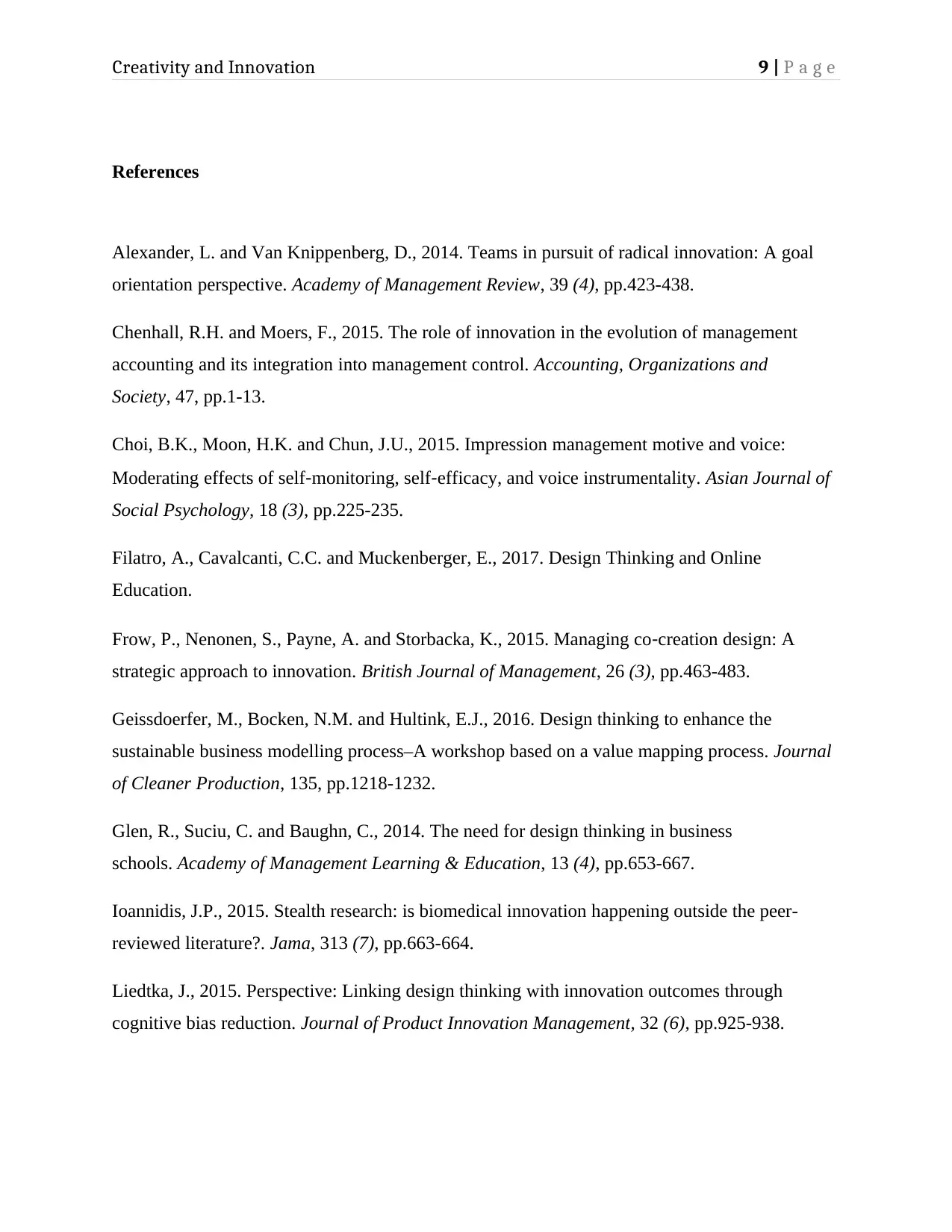
Creativity and Innovation 9 | P a g e
References
Alexander, L. and Van Knippenberg, D., 2014. Teams in pursuit of radical innovation: A goal
orientation perspective. Academy of Management Review, 39 (4), pp.423-438.
Chenhall, R.H. and Moers, F., 2015. The role of innovation in the evolution of management
accounting and its integration into management control. Accounting, Organizations and
Society, 47, pp.1-13.
Choi, B.K., Moon, H.K. and Chun, J.U., 2015. Impression management motive and voice:
Moderating effects of self‐monitoring, self‐efficacy, and voice instrumentality. Asian Journal of
Social Psychology, 18 (3), pp.225-235.
Filatro, A., Cavalcanti, C.C. and Muckenberger, E., 2017. Design Thinking and Online
Education.
Frow, P., Nenonen, S., Payne, A. and Storbacka, K., 2015. Managing co‐creation design: A
strategic approach to innovation. British Journal of Management, 26 (3), pp.463-483.
Geissdoerfer, M., Bocken, N.M. and Hultink, E.J., 2016. Design thinking to enhance the
sustainable business modelling process–A workshop based on a value mapping process. Journal
of Cleaner Production, 135, pp.1218-1232.
Glen, R., Suciu, C. and Baughn, C., 2014. The need for design thinking in business
schools. Academy of Management Learning & Education, 13 (4), pp.653-667.
Ioannidis, J.P., 2015. Stealth research: is biomedical innovation happening outside the peer-
reviewed literature?. Jama, 313 (7), pp.663-664.
Liedtka, J., 2015. Perspective: Linking design thinking with innovation outcomes through
cognitive bias reduction. Journal of Product Innovation Management, 32 (6), pp.925-938.
References
Alexander, L. and Van Knippenberg, D., 2014. Teams in pursuit of radical innovation: A goal
orientation perspective. Academy of Management Review, 39 (4), pp.423-438.
Chenhall, R.H. and Moers, F., 2015. The role of innovation in the evolution of management
accounting and its integration into management control. Accounting, Organizations and
Society, 47, pp.1-13.
Choi, B.K., Moon, H.K. and Chun, J.U., 2015. Impression management motive and voice:
Moderating effects of self‐monitoring, self‐efficacy, and voice instrumentality. Asian Journal of
Social Psychology, 18 (3), pp.225-235.
Filatro, A., Cavalcanti, C.C. and Muckenberger, E., 2017. Design Thinking and Online
Education.
Frow, P., Nenonen, S., Payne, A. and Storbacka, K., 2015. Managing co‐creation design: A
strategic approach to innovation. British Journal of Management, 26 (3), pp.463-483.
Geissdoerfer, M., Bocken, N.M. and Hultink, E.J., 2016. Design thinking to enhance the
sustainable business modelling process–A workshop based on a value mapping process. Journal
of Cleaner Production, 135, pp.1218-1232.
Glen, R., Suciu, C. and Baughn, C., 2014. The need for design thinking in business
schools. Academy of Management Learning & Education, 13 (4), pp.653-667.
Ioannidis, J.P., 2015. Stealth research: is biomedical innovation happening outside the peer-
reviewed literature?. Jama, 313 (7), pp.663-664.
Liedtka, J., 2015. Perspective: Linking design thinking with innovation outcomes through
cognitive bias reduction. Journal of Product Innovation Management, 32 (6), pp.925-938.
Paraphrase This Document
Need a fresh take? Get an instant paraphrase of this document with our AI Paraphraser
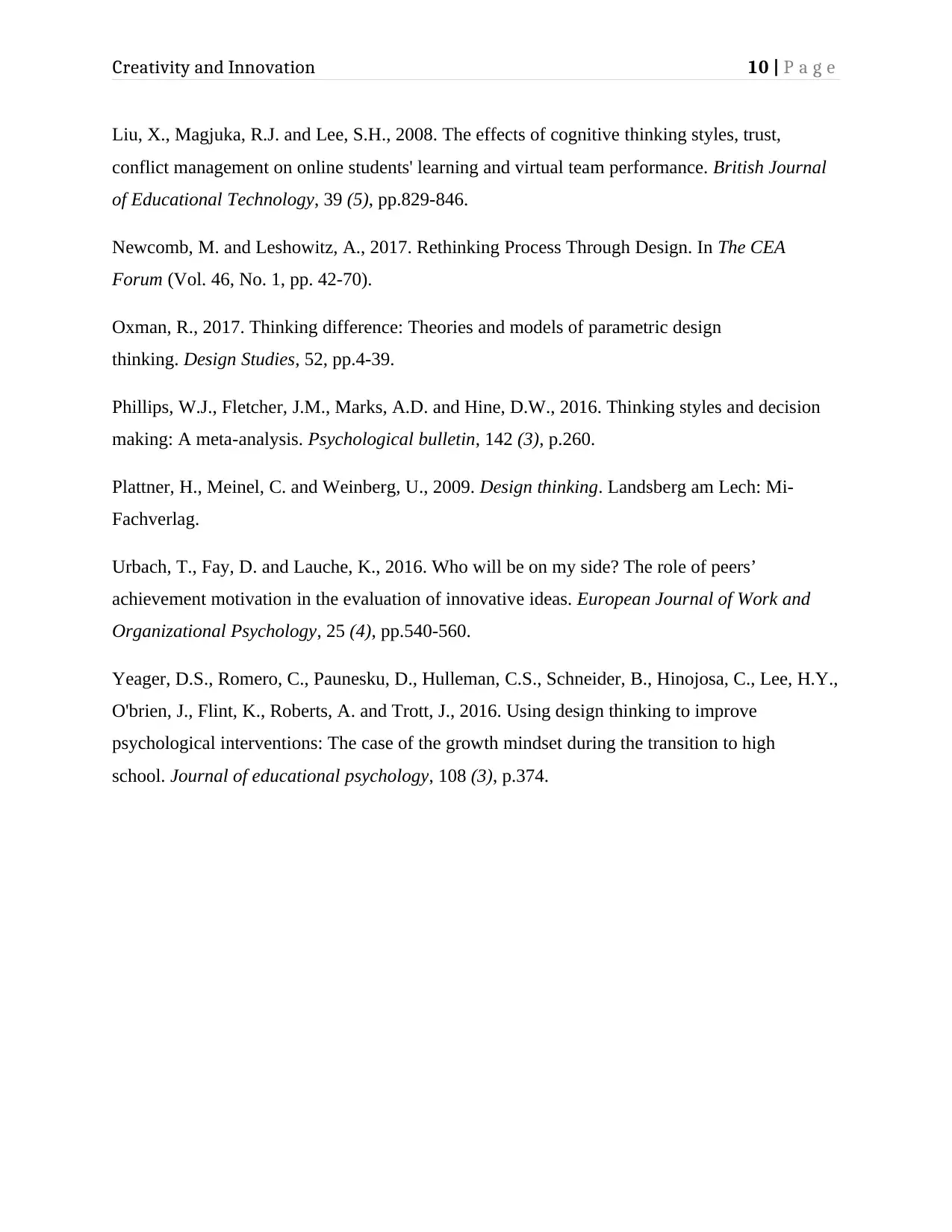
Creativity and Innovation 10 | P a g e
Liu, X., Magjuka, R.J. and Lee, S.H., 2008. The effects of cognitive thinking styles, trust,
conflict management on online students' learning and virtual team performance. British Journal
of Educational Technology, 39 (5), pp.829-846.
Newcomb, M. and Leshowitz, A., 2017. Rethinking Process Through Design. In The CEA
Forum (Vol. 46, No. 1, pp. 42-70).
Oxman, R., 2017. Thinking difference: Theories and models of parametric design
thinking. Design Studies, 52, pp.4-39.
Phillips, W.J., Fletcher, J.M., Marks, A.D. and Hine, D.W., 2016. Thinking styles and decision
making: A meta-analysis. Psychological bulletin, 142 (3), p.260.
Plattner, H., Meinel, C. and Weinberg, U., 2009. Design thinking. Landsberg am Lech: Mi-
Fachverlag.
Urbach, T., Fay, D. and Lauche, K., 2016. Who will be on my side? The role of peers’
achievement motivation in the evaluation of innovative ideas. European Journal of Work and
Organizational Psychology, 25 (4), pp.540-560.
Yeager, D.S., Romero, C., Paunesku, D., Hulleman, C.S., Schneider, B., Hinojosa, C., Lee, H.Y.,
O'brien, J., Flint, K., Roberts, A. and Trott, J., 2016. Using design thinking to improve
psychological interventions: The case of the growth mindset during the transition to high
school. Journal of educational psychology, 108 (3), p.374.
Liu, X., Magjuka, R.J. and Lee, S.H., 2008. The effects of cognitive thinking styles, trust,
conflict management on online students' learning and virtual team performance. British Journal
of Educational Technology, 39 (5), pp.829-846.
Newcomb, M. and Leshowitz, A., 2017. Rethinking Process Through Design. In The CEA
Forum (Vol. 46, No. 1, pp. 42-70).
Oxman, R., 2017. Thinking difference: Theories and models of parametric design
thinking. Design Studies, 52, pp.4-39.
Phillips, W.J., Fletcher, J.M., Marks, A.D. and Hine, D.W., 2016. Thinking styles and decision
making: A meta-analysis. Psychological bulletin, 142 (3), p.260.
Plattner, H., Meinel, C. and Weinberg, U., 2009. Design thinking. Landsberg am Lech: Mi-
Fachverlag.
Urbach, T., Fay, D. and Lauche, K., 2016. Who will be on my side? The role of peers’
achievement motivation in the evaluation of innovative ideas. European Journal of Work and
Organizational Psychology, 25 (4), pp.540-560.
Yeager, D.S., Romero, C., Paunesku, D., Hulleman, C.S., Schneider, B., Hinojosa, C., Lee, H.Y.,
O'brien, J., Flint, K., Roberts, A. and Trott, J., 2016. Using design thinking to improve
psychological interventions: The case of the growth mindset during the transition to high
school. Journal of educational psychology, 108 (3), p.374.
1 out of 11
Related Documents
Your All-in-One AI-Powered Toolkit for Academic Success.
+13062052269
info@desklib.com
Available 24*7 on WhatsApp / Email
![[object Object]](/_next/static/media/star-bottom.7253800d.svg)
Unlock your academic potential
Copyright © 2020–2025 A2Z Services. All Rights Reserved. Developed and managed by ZUCOL.




